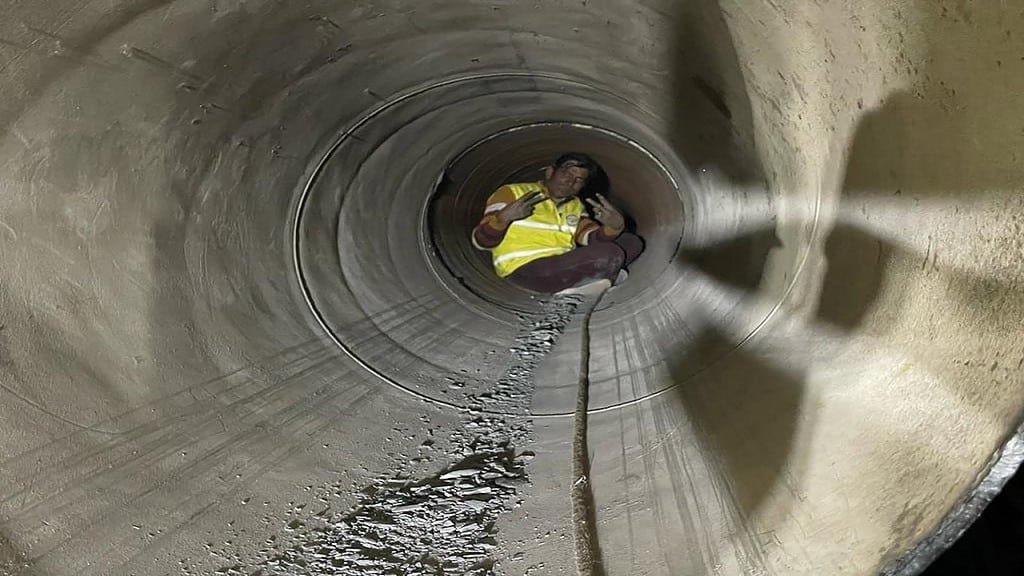Greetings builders and enthusiasts! Today, our construction chronicles take us to the heart of Uttarkashi, where a tale of resilience and unconventional mining techniques unfolds. As the dust settles from the recent Silkyara tunnel collapse, the spotlight shines on a unique method known as “Rat Mining” that played a pivotal role in rescuing trapped workers.
Let’s peel back the layers and explore the intricacies of this method, the challenges faced, and its significance in the context of the Uttarkashi tunnel. So, what’s the deal with Rat Mining, you ask? Let’s break it down.
Table of Contents
ToggleFirst Understand, What happened at Silkyara tunnel in Uttarkashi
In a gripping rescue operation spanning seventeen days, the collapsed Silkyara tunnel in Uttarkashi has seen a glimmer of hope as pipes were successfully laid in the final stretch to facilitate the rescue of 41 trapped workers. Ambulances, garlands, and hospital beds stand ready for the workers’ triumphant emergence.
In the dramatic rescue operation at the Silkyara tunnel in Uttarkashi, Firoz Qureshi and his team of manual excavators, often referred to as “rat-hole miners,” played a crucial role in freeing 41 trapped workers after more than 16 days. The collapsed tunnel, part of the flagship Char Dham project, faced challenges when a landslide caused a section to cave in on November 12.
Challenges with Auger Machine and Manual Intervention
The rescue operation faced setbacks when the main auger drilling machine broke down inside the tunnel. Auger machines are equipped with rotating blades for drilling, and a machine powered by an engine, electric motor, or hydraulic power. The blades encountered steel rebars at 39m and later became entangled in debris at 48m.
A team of mechanics and manual excavators, armed with gas torches, entered the pipe to cut through the steel rebars and clear the entangled blades. The manual intervention, involving continuous threats of burn injuries, showcased the stamina and experience of the tunneling mechanics.
What’s Rat Mining All About?
Rat Mining, or more formally known as “rat-hole” mining, is a manual drilling technique that’s been making waves, and not the good kind. Imagine skilled workers digging narrow pits into the ground, just enough for one brave soul to descend and extract coal. It’s a bit like searching for treasure in a confined space, except the stakes are higher, and there’s no pirate map.
The term “rat hole” aptly describes these small pits, emphasizing their cramped and perilous nature. Miners descend into these holes using ropes and bamboo ladders, facing risks such as asphyxiation, lack of oxygen, and hunger. This method, illegal in many countries, has been a cause for concern due to its high fatality rate and adverse environmental impact.
A Brief History: Why “Rat Hole” Mining?
Rat-hole mining has its roots in Meghalaya, where nimble miners, often slim fellas, would venture into these tight spaces to extract coal. However, the Supreme Court in 2014 gave it the red card, but like that stubborn weed in your garden, it continues to pop up illegally.
At the heart of this rescue operation lies the unconventional technique known as ‘rat mining.’ This method involves manual drilling by skilled workers, a practice most commonly associated with Meghalaya. In this hazardous process, narrow pits are dug into the ground, only wide enough for one person to descend and extract coal.

Applications and why is it Ban?
Rat mining might sound like a cool adventure, but it comes with a laundry list of problems. The technique, primarily used for coal extraction, faced the music when the National Green Tribunal (NGT) banned it in 2014 and reiterated the ban in 2015.
Moreover, the mining process contributes to land degradation, deforestation, and water pollution, raising alarms about the long-term environmental consequences. The NGT, in its observations, highlighted the influx of water into mining areas during the rainy season, leading to fatalities. Unregulated mines lacking safety measures, such as proper ventilation and structural support, create perilous working conditions for rat miners
Why, you ask?
Think hazardous working conditions, environmental damage, and numerous accidents leading to injuries and fatalities. Not exactly the kind of rave reviews you’d want for a mining technique.
The Dark Side of the Rat Mining
Experts point fingers at the lack of regulation in these mines, with safety measures like proper ventilation and structural support taking a backseat. Land degradation, deforestation, and water pollution add to the laundry list of why rat-hole mining is frowned upon.
Are There Any Advantages of Rat Mining?
Are there any silver linings in this dark tunnel? Well, not really. The ban suggests that the disadvantages far outweigh any potential benefits. The NGT wasn’t throwing a party when they clamped down on this method.
Now, before you start thinking that all hope is lost, let’s consider this: the NGT banned rat-hole mining for a reason. But can there be a middle ground? Is there a way to improve the process, making it safer and more environmentally friendly? It’s a question worth pondering as we navigate the ever-evolving landscape of construction techniques.
Alternative Rescue Methods
Apart from rat mining, the rescue operation in the Uttarkashi tunnel employed alternative methods to free the trapped workers:
Vertical Drilling:
This method involves boring straight down from the ground using electrical tools and equipment. In this case, a vertical drill was used to create an opening, and an 800-mm pipe was inserted to facilitate the workers’ extraction.
Auger Mining (Horizontal Drilling):
Auger machines or directional drills are specialized tools for horizontal drilling without disturbing the ground. In the Uttarakhand tunnel collapse, the auger machine faced challenges, hitting metal obstructions and eventually breaking down, rendering it ineffective in freeing the trapped workers.
As the rescued workers prepare to step back into the light, the Uttarkashi tunnel collapse serves as a stark reminder of the risks associated with unconventional mining practices and the critical need for stringent safety measures in such operations.
In Conclusion:
In the echoing chambers of the Silkyara tunnel, we’ve witnessed the triumphs and challenges of the recent rescue operation. The unconventional heroes, often referred to as “rat-hole” miners, emerged victorious, clearing the debris and paving the way for the trapped workers’ freedom. As we bid farewell to this chapter, let’s reflect on the lessons learned.
The ban on rat-hole mining speaks volumes about the need for safer and more sustainable practices in construction. In the shadows of adversity, a glimmer of hope arises—a hope for a future where innovation and safety go hand in hand, ensuring that every structure built stands on a foundation of resilience and responsibility. Perhaps, with a collective effort, we can move towards practices that not only build structures but also build a sustainable and safer future for all.
Stay tuned for more construction chronicles, and remember, safety first, adventurers!





